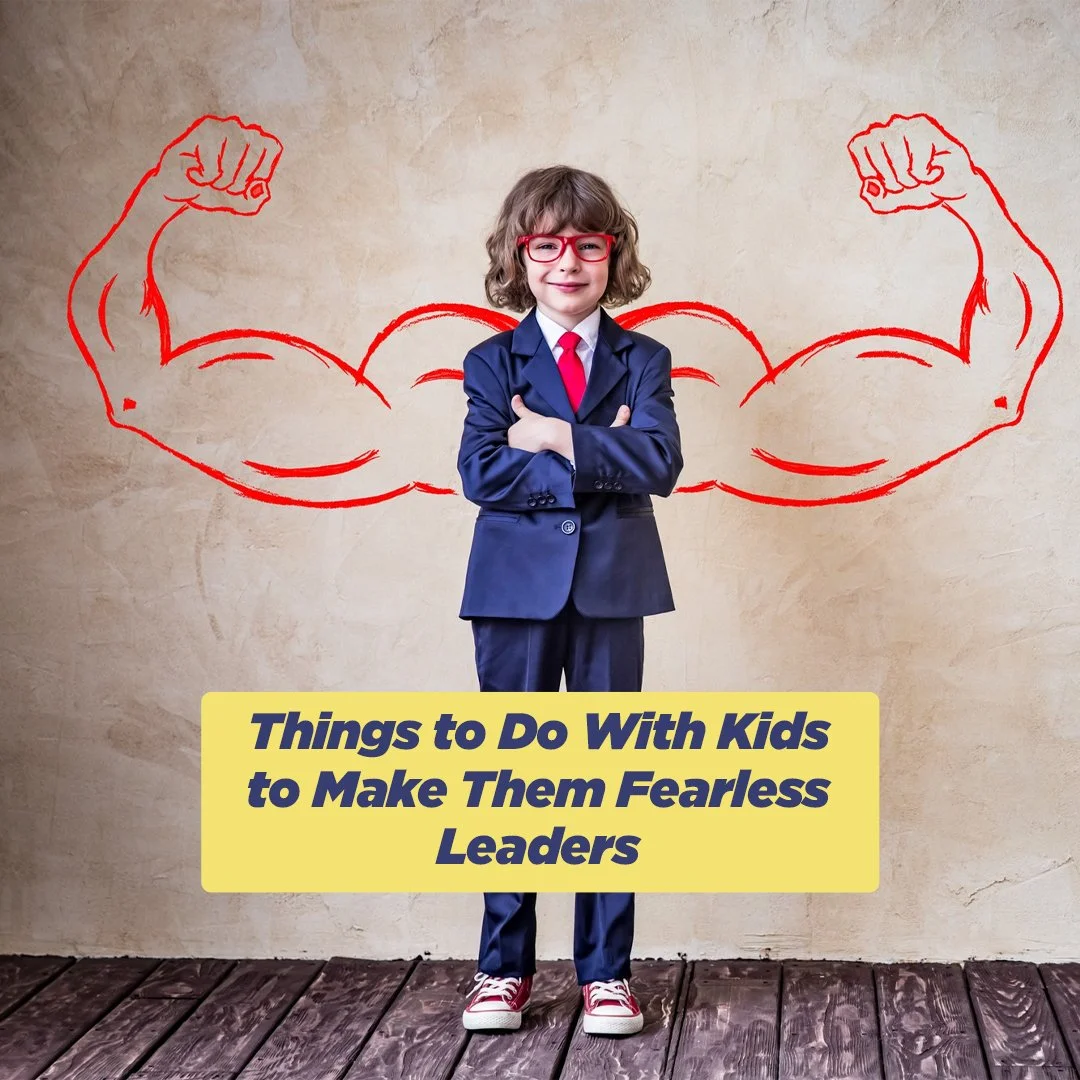Things to Do With Kids to Make Them Fearless Leaders
Have you ever wondered how to raise a child and what things to do with kids who can confidently face the challenges of tomorrow? As parents, the dream is simple: we want our children to shine, inspire, and lead. But in the fast-paced whirlwind of modern life, nurturing leadership often feels like a daunting puzzle. How do you teach confidence when self-doubt creeps in? How do you foster decision-making skills when choices seem endless?
Raising a future leader isn’t about preparing them to run boardrooms or lead rallies—it’s about giving them the tools to navigate life with resilience, empathy, and conviction. Imagine a child who speaks up in a crowded room, stands firm in their values, and inspires others with their actions. Leadership isn’t a trait they are born with; it’s a skill they learn, one step at a time.
Parents often balance meeting academic expectations, managing extracurriculars, and teaching life lessons. But amidst these responsibilities lies a golden opportunity: to plant the seeds of leadership early on. With the right guidance, you can help your child grow into someone who can lead and uplift others.
In this blog, we’ll uncover the benefits of leadership for children, explore different types of leadership, and share actionable ways to nurture these skills. Let’s embark on this journey together and unlock the immense potential within every child because the decisions we make now will determine the leaders of tomorrow.
Benefits of Leadership for Children
When you picture a young leader, it’s not about commanding a room or making executive decisions. It’s about the spark of confidence in their eyes when they solve a problem, the courage they show in standing up for a friend, or the creativity they use to organise a group activity. Leadership in children is subtle yet powerful—it’s the foundation for a future filled with potential.
Here’s why nurturing leadership skills in your child can make all the difference:
Their Self-Confidence Will Grow
Leadership experiences act as stepping stones for children to trust their abilities. When they take the lead in small tasks—like organising a game in soft play zones or presenting a school project—they learn to overcome doubts and embrace their strengths. Confidence isn’t built overnight; it grows with every little victory.
Parents often notice their children hesitate or fear failure. By encouraging leadership, you’re teaching them that it’s okay to stumble as long as they rise again.
Recognize Their Needs
Children who lead learn to understand themselves. Leadership teaches kids to reflect on their strengths, identify their passions, and even recognise areas for improvement. This self-awareness becomes their compass, guiding them through life’s challenges. When children know their needs, they make better choices.
As a parent, imagine a child who chooses to try a new hobby because they’ve realised it aligns with their goals—this is the power of self-recognition through leadership.
Learn to Speak Up
Leadership nurtures the courage to express thoughts and ideas. Whether it’s voicing an opinion during family discussions or advocating for a friend at school, children learn that their voice matters.
In the modern world, remaining mute frequently results in lost opportunities. By teaching your children to speak up, you’re giving them the tools to navigate conflicts, build relationships, and inspire change.
Build Essential Skills
Leadership is a workshop for essential life skills. Decision-making, critical thinking, and problem-solving come naturally to children who lead. Think of leadership as a playground for the mind—it’s where children experiment, learn, and grow.
For example, when your child plans a small event or resolves a group conflict, they’re indirectly preparing for real-world challenges. These skills aren’t just useful; they’re transformative.
Leadership Qualities Across Age Groups
| Age Group Example | Leadership Behaviors |
|---|---|
| Preschool (3–5) | Organising group activities, standing up for others |
| Elementary (6–11) | Organising group activities, standing up for others |
| Middle School (12–14) | Taking on class responsibilities, mentoring younger students |
| High School (15–18) | Leading clubs, initiating community projects |
As we see, leadership isn’t a single trait—it’s a collection of qualities nurtured over time. But what does leadership look like in different areas of life? Let’s explore the three types of leadership every child should develop to thrive in a dynamic world.
Three Types of Leadership Every Child Needs
Leadership isn’t one-size-fits-all; it’s a blend of skills shaped by experiences. Nurturing various leadership types is crucial in raising a well-rounded leader, influencing a child’s independence, relationships, and worldview. Let’s explore these three leadership pillars and their role in your child’s development.
Self-Leadership
Self-leadership is where it all begins. It’s about teaching children to take responsibility for their actions, set personal goals, and hold themselves accountable. Imagine a child who wakes up early to finish their homework or packs their bag for school or play centres—they’re practising self-leadership
This type of leadership fosters independence and resilience. Children who lead themselves become problem-solvers who don’t wait for others to fix things. For parents, the challenge often lies in balancing guidance with autonomy. By encouraging small, everyday acts of self-leadership, you’re empowering your child to trust their judgment.
Leadership with Others
Leadership isn’t just about leading oneself—it’s also about leading others. Whether it’s collaborating on a group project or resolving conflicts with friends, children learn to build trust, communicate effectively, and inspire their peers.
Picture your child organising a group activity at a birthday party at birthday events for children in play centres, ensuring everyone feels included. This type of leadership teaches them empathy and the power of shared goals. As they grow, these experiences shape them into individuals who influence others positively, fostering teamwork in every aspect of life.
Leadership in Community
Leadership takes on a broader meaning when children step into their communities. This is about instilling a sense of civic responsibility and teaching them the value of giving back. From volunteering at local events to initiating clean-up drives, children learn that they can make a difference.
When your child organises a charity fundraiser or supports a community project, they’re not just helping others—they’re building a legacy. Leadership in the community teaches children the importance of being proactive, compassionate, and socially conscious. This type of leadership often leaves a lasting impact, shaping them into responsible citizens.
Now that we’ve seen how leadership manifests in different areas, it’s time to understand the core qualities that make a great leader. Let’s dive into the 5 Cs of leadership and explore how they shape a child’s character.
The 5 C’s of Leadership
Leadership is built on a strong foundation of essential qualities that shape how children inspire, guide, and connect with others. These "5 C’s" are the cornerstones of a great leader, influencing everything from decision-making to problem-solving.
Credibility: Credibility begins with honesty and reliability. Children who are trustworthy gain the respect of both adults and their peers. When a child keeps their promises, they learn the value of integrity, the first step in becoming a leader others can rely on.
Communication: Clear communication is the heart of leadership. It teaches children to express themselves, listen actively, and resolve conflicts. Great leaders don’t just talk—they connect.
Commitment: Commitment is about dedication. Whether it’s sticking to a project or helping a friend, it teaches responsibility and perseverance. A committed child understands the importance of seeing things through.
Confidence: Confidence encourages children to take initiative and believe in themselves. A confident leader inspires others to follow, turning dreams into action.
Creativity: Creativity fuels problem-solving and thinking outside the box. When children approach challenges innovatively, they learn that leadership isn’t just about following rules but reimagining them.
With the 5 C’s in mind, let’s explore practical ways to develop these qualities and help your child become a future leader.
8 Things To Do With Kids to Develop Leadership Skills
Leadership isn’t a trait children are born with; it’s a skill they learn through experiences. Parents often wonder, "How do I nurture a leader in my child without overwhelming them?" Let’s explore eight practical things to do with kids to shape your child into a confident leader.
Promote Teamwork
Encourage your child to participate in group activities like sports, drama, or collaborative games - play centres can help a lot in this. These experiences teach them to share responsibilities, resolve conflicts, and work toward a common goal. Teamwork isn’t just about winning—it’s about learning to lead and follow with grace.
Volunteering Activities
Volunteering helps children step out of their comfort zones and contribute meaningfully. Whether it’s cleaning the park or helping at a food bank, such activities develop initiative, empathy, and responsibility. Children feel empowered to effect change when they witness the results of their efforts.
Set Good Examples
Children are like mirrors; they reflect what they observe. Model behaviours such as honesty, perseverance, and empathy. Spend time with them while they play and learn at play centres in daily life. When you lead with integrity, you’re teaching your child the foundation of strong leadership.
Enroll in Play Centers
Play centres are excellent for developing leadership skills. Many UK-based centres, such as Wonderland Soft Play Zone and inter-group competition, offer programs focused on teamwork, decision-making, and problem-solving. These spaces provide a safe, fun environment for children to grow as leaders.
Give Them Choices
From choosing their outfit to planning family meals, give your child opportunities to make decisions. These small choices teach accountability and boost confidence. Making decisions is the foundation of leadership, not merely a talent.
Teach Communication Skills
Leadership thrives on effective communication. Help your child practice clear speaking, active listening, and interpreting non-verbal cues. When children can express their ideas confidently, they’re already ahead in the leadership game.
Let Them Choose Their Trail
Allow your child to pursue their interests and learn from mistakes. Whether it’s starting a hobby or tackling a school project, autonomy fosters resilience and self-leadership. Leaders aren’t afraid to stumble—they learn and grow stronger.
Nurture an Entrepreneurial Spirit
Introduce your child to small ventures, like managing a lemonade stand or planning a fundraiser. These projects teach budgeting, planning, and problem-solving while igniting creativity. Entrepreneurial activities give children a taste of leadership and responsibility.
Each of these methods plants the seeds of leadership.
Shaping the Leaders of Tomorrow
Leadership is a compass guiding children toward confidence and success. As parents, you shape this journey by providing tools and experiences that help mould your child into a compassionate, resilient leader. Every small effort—like encouraging teamwork, nurturing creativity, or fostering decision-making—contributes to their brighter future.
It’s not always easy. Balancing daily responsibilities with your child’s growth journey can feel overwhelming. But remember, every step counts. By taking action today, you’re paving the way for your child to become a leader who inspires and uplifts others.
If you’re seeking the perfect environment to nurture these skills, consider exploring specialised play centres like Wonderland, where learning meets fun. With tailored activities designed to foster leadership and creativity, your child can develop in an engaging and supportive atmosphere.
We’d love to hear from you! Share your stories about fostering leadership in your child or ask any questions in the comments below. What’s your next step in shaping your child’s leadership journey? Visit Wonderland and discover how we can help make it happen.
FAQ’s
-
Encourage them to step out of their comfort zone by praising effort over outcome and teaching them to view failures as learning opportunities.
-
Model leadership qualities, provide opportunities for teamwork, and nurture decision-making and communication skills through everyday activities.
-
Empower them with self-confidence, teach resilience through challenges, and foster a growth mindset with positive reinforcement.
-
Build their confidence by supporting small risks, celebrating achievements, and showing them the value of perseverance and courage.
-
Leaders are made through consistent learning, experiences, and nurturing the right qualities like confidence, empathy, and decision-making skills.




